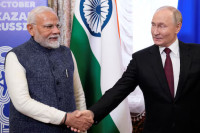Columns
The future of the classroom is online
The government must support universities as they move to embrace virtual teaching-learning practises.
Achyut Wagle
The prospects and possibilities of online education, or e-learning, have been experimented with ever since the advent of the internet and the subsequent development of interactive virtual platforms based on it. Some idea of distance or remote learning was already in discussion and practise, with different modalities including snail mail, radio or, lately, television to deliver lessons to students. But until the novel coronavirus pervaded the world with unprecedented speed and wrath, the scope of online education was deemed only a supplement or an alternative to the physical, universally-employed mode. Some 'open universities' certainly tried hard to make online courses a mainstream practice in tertiary education but not without considerable caveats on their trust, efficacy, quality and accreditation.
With the onslaught of Covid-19, educational institutions the world over became the first and immediate victims of the lockdowns imposed to contain the spread of SARS-CoV-2. According to a World Bank estimate, this brought the classes of more than one billion students to a grinding halt. Out of them, over 220 million post-secondary students—13 percent of the total number of students affected globally—have had their studies ended or significantly disrupted due to the pandemic. South Asia, home to 40 million tertiary level students is one of the black spots, with total closure for the last six months. Nepal's 8.8 million students fall among them. Even worse, the uncertainty of reopening of the academic institutions persists, as the spread of the virus continues.
Nevertheless, there is a silver lining, the global lockdown has helped to highlight the importance and necessity of online education in the global academic discourse, with vigour like never before. Of course, there are a plethora of deeper problems, more pronounced in the developing countries, like the digital divide and exclusion, underinvestment and poor infrastructure. The viability of the online mode of teaching as a substitute for face-to-face methods is in question. What is extremely important here is the meaningful debate itself; without which the challenges faced by the online education so far were left ignored and, thus, scopes untapped.
In the initial stage of the Covid-19 lockdowns, online education everywhere was taken as a stopgap arrangement to engage students while everyone hoped for a quick return to normality. But, the unabated spread of the virus and uncertainty over the availability of a viable vaccine or cure anytime soon are forcing all stakeholders in education—the policy-makers, educational institutions, parents and students—to resort to 'some' solutions beyond mere engagement that also saves from the loss of the entire academic year and graduation calendar. For this, online education, mainly internet platform-based virtual classes, is turning out to the best alternative compared to several other forms of remote learning methods like teaching through the radio or television.
From the perspective of actual educational attainment, the tertiary level is rightly at the centre of the new normal. Several factors including students' maturity, digital access and literacy, and students' urgency to join the job market attaining the degree sooner make online education more tenable and productive for this level. Challenges certainly persist. Apart from pre-existing bottlenecks of connectivity and bandwidth, digital exclusion in terms of affordability of devices, the internet and digital skills, the greatest new challenge, lies in developing the entire ecosystem of the teaching-learning process that is comparable to the existing face-to-face system and equally fit to validate. For this to happen, the ecosystem must be able to incorporate every stage of the administrative processes in education—admission, class delivery, examination, and the awarding of the academic degree.
Universities lagging behind
The Ministry of Education published the Student Learning Facilitation Guide for Alternative Systems 2020 focusing on high school education, which comes into force from September 17, 2020. It has created five categories of students on the basis of the availability, or the lack thereof, of the means to access 'distant' education. The demand side pressure from the municipality authorities and their willingness to implement the guidelines, thanks to the weight of federalism and decentralised democracy, enabled the ministry to come up with these revised guidelines. But for university education, such pressure has largely been absent. The University Grant Commission (UGC) assigned to formulate similar guidelines for tertiary education is yet to come up with the final product. Most of the universities citing logistical impossibility were late to recognise the importance of online education and explore the possibility of implementing the same.
It is true that structural barriers to online education in Nepal are relatively very high. According to Nepal Telecommunications Authority, although 72 percent of the people are connected to some form of internet, mainly through handheld devices to use social media, only around 12 percent of the people have a broadband internet connection. The quality of connection that can stream video, required for online classes, is limited only to urban areas.
Not only students but teachers of all levels also are far short of digital skills to use widely available learning management solutions. Many higher education institutions still do not provide personalised, institution-based email accounts. The majority of the parents may not be able to support their children to effectively use digital devices. Less than 15 percent of Nepalis are thought to possess personal computers. The education policies are inadequate and less targeted to take these impediments head-on.
One success story
Despite such adversities, Kathmandu University (KU) has managed to seamlessly operationalise the entire 'ecosystem' of online education. This includes admitting a new batch of students, conducting online entry tests, teaching the entire semester virtually, taking all required examinations and publishing the results online. It would, though, be an overstatement to claim that the transition went without hiccups and challenges.
Kathmandu University, under its seven different schools, accounts for 5 percent of 400,000 tertiary level students in Nepal. Nevertheless, the online education protocols developed and implemented by KU to cover every aspect of the teaching-learning 'ecosystem' as mentioned are indeed a national achievement that can serve as national public goods.
It is undoubtedly the responsibility of the state to timely calibrate policies to recognise online education—not only to address the Covid-19 induced crisis but to make virtual classrooms an integral part of the national education system. The development and accessibility of quality connectivity infrastructure is undoubtedly the key prerequisite, but to reduce digital exclusion, it is high time now for the state to make the internet a free public good. The responsibility and challenge for educational institutions are to customise their course content and class delivery systems to suit virtual needs. The next necessary step should be a coordinated national policy on the basis of the best practices that have so far produced desirable results in higher education.
***
What do you think?
Dear reader, we’d like to hear from you. We regularly publish letters to the editor on contemporary issues or direct responses to something the Post has recently published. Please send your letters to [email protected] with "Letter to the Editor" in the subject line. Please include your name, location, and a contact address so one of our editors can reach out to you.




 8.12°C Kathmandu
8.12°C Kathmandu













%20(1).jpg&w=300&height=200)

